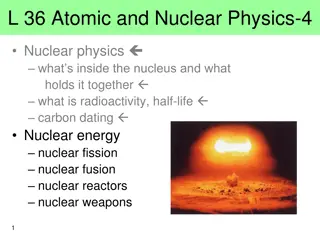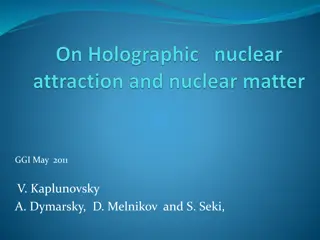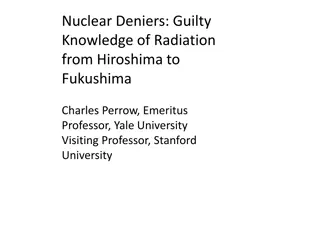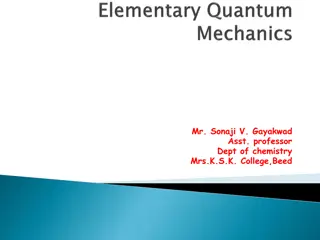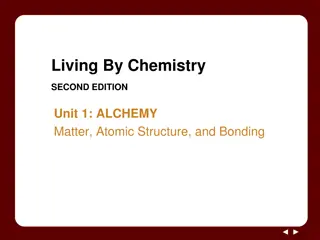Understanding Nuclear Physics and Radiation Hazards
Delve into the realm of modern physics exploring nuclear reactions, radioactivity, biological effects of nuclear radiation, and hazards of radiation exposure. Learn about the structure of the nucleus, nuclear energy, and the potential dangers of ionizing radiation on biological systems and human health.
Download Presentation

Please find below an Image/Link to download the presentation.
The content on the website is provided AS IS for your information and personal use only. It may not be sold, licensed, or shared on other websites without obtaining consent from the author. Download presentation by click this link. If you encounter any issues during the download, it is possible that the publisher has removed the file from their server.
E N D
Presentation Transcript
PHYS:1200 No class: Friday May 1 We will review the practice final exam questions on Monday May 4 and Wednesday May 6. No class: Friday May 8 Final Exam: Wednesday May 13 3 5 PM in LR1 VAN ( right here! ) 1
L 36 Modern Physics - 4 Nuclear physics what s inside the nucleus and what holds it together what is radioactivity, half-life carbon dating Nuclear energy nuclear fission nuclear fusion nuclear reactors nuclear weapons 2
Radioactivity Some nuclei are unstable and spontaneously emit particles at random times Alpha particles (helium nucleus) Beta particles energetic electrons Gammas - energetic photons (higher than x-rays) The beta particles (electrons) come from a process called beta decay, in which a neutron decays into a proton, an electron and an antineutrino (note that charge is conserved!) n o 1 4 2 He + + + 1 1 p e 3
Nuclear reactions: E = mc2 Energy is released in the fission (breakup) of a heavy nucleus by fast neutron bombardment 239 94Pu + + + 1 0 239 94 96 38 143 56 1 0 n Pu Sr Ba n mass = 240.06 units mass = 239.86 units The extra mass is converted into kinetic energy, which is mostly in the neutrons. 4
Biological effects of nuclear radiation Nuclear reactions can produce alphas, betas, neutrons and gamma radiation (particles or photons) Nuclear radiation is ionizing radiation, i.e., energetic enough to knock electrons out of atoms or molecules Ionizing radiation is potentially harmful to humans because the ionization it produces can alter significantly the structure of molecules within a living cell which can lead to alterations of the cell (make them cancerous) or to the death of the cell 5
Hazards of radiation The hazards of radiation can be minimized by limiting overall exposure The effects of absorbed doses or ionizing radiation is measured in a unit called the rem. The effects of radiation exposure are Short term or acute effects appearing within a matter of minutes of exposure Long-term effects that may appear in years, decades or even in future generations 6
Average radiation doses receivedby a US resident Source of radiation dose in mrem/yr* Natural Background radiation Cosmic rays ...............................28 Earth and air .28 Internal radioactive nuclei ..39 Inhaled radon .200 Man-made radiation Medical / dental x-rays 39 Nuclear medicine .14 *Current federal standards limit exposure to 500 mrem/yr 7
Radiation sickness This is the general term applied to the acute effects of radiation A dose less than 50 rem causes no short term ill effects A dose of 50 300 rem at one time brings on radiation sickness A whole body dose of 400 500 rem is lethal for about 50% of people exposed Whole body doses greater than 600 rem results in death for almost all individuals 8
Nuclear Physicists Otto Hahn and Lise Meitner discovered fission. Only Hahn won the Nobel Prize. Meitner should also have won. Marie Curie discovered radioactivity. First woman to win a Nobel Prize. Won 2 Nobel prizes in Physics and Chemistry. Enrico Fermi Father of the Atomic bomb Won Nobel prize for discovering new radioactive elements. Edward Teller Father of the Hydrogen bomb Convinced Pres. Reagan to pursue the Star Wars project. 9
Energy from the nucleus Huge amounts of energy are given off in two nuclear processes Nuclear fission: splitting a heavy nucleus in two Nuclear fusion: fusing two light nuclei into one 10
A lot of energy from a little mass The energies released when a large nucleus undergoes fission or small nuclei undergo fusion are enormous compared to chemical energies (e.g. burning fossil fuel) When Uranium splits apart about 0.1% of its mass is converted into energy Pound for pound, nuclear reactions release about 10 million times more energy than chemical reactions 1 pound Uranium 1 million gallons of gasoline 11
Splitting the atom Nuclear Fission To split a uranium nucleus apart takes energy A neutron hitting a uranium nucleus can cause it to split A neutron can split U- 235 into Cs-143 and Rd-90 plus a few extra neutrons 12
The nuclear chain reaction When U-235 splits, on average 2.5 neutrons are released These neutrons can then go on to cause other U- 235 s to split, this resulting in a chain reaction This can result in a catastrophic process with enormous energy released. 13
Reactor or Bomb If the energy released in a nuclear chain reaction is allowed to proceed in a controlled way, then this can be used as an energy source nuclear reactor If the chain reaction occurs in an uncontrolled manner then you have atomic bomb Enrico Fermi produced the first nuclear reactor under the west stands of Stagg Field at the University of Chicago in 1942 14
Electricity generation by nuclear power Percentage of electricity produced by nuclear power France: 73% Belgium: 52% Slovakia: 54% Switzerland: 36% Sweden: 43% USA: 19% Germany: 18% Japan: 18% Russia: 18% UK: 18% Canada: 15% Argentina: 7% China: 2% Nuclear Power Plant Steel and Concrete Containment vessel 15
Nuclear reactors The fuel elements contain the fissile fuel in the form of rods of 1 cm diameter. There may be thousands of such rods stacked together in the reactor core The most common fuel is enriched U-235 Some type of moderator material is also used to slow down the neutrons to make their capture more efficient 16
A nuclear power plant Electric transmission 17 Electric generator Nuclear reactor
Reactor operation The reactor is usually operated in the so- called critical state in which each fission leads to only one additional fission. In the critical state the reactor produces a steady output of electrical energy The reactor is designed not to go into the supercritical state in this state the reactor produces an uncontrolled and increasing amount of energy which can cause it overheat and lead to meltdown. 18
Controlling the nuclear reactor To keep the reactor in the critical state the operators adjust the control rods The control rods can be moved into or out of the reactor core. They contain an element, such as cadmium or boron which absorbs neutrons. If the reactor is getting too hot, the control rods are pushed into the core to slow down the chain reaction The heat generated within the fuel rods is carried away by water surrounding the rods 19
Reactor core To start the reactor, the control rods are pulled out of the core To stop the reactor, the control rods are pushed into the core Inside a concrete containment vessel 20
Pros and Cons of Nuclear energy ADVANTAGES Plentiful fuel no greenhouse gases no poisonous emissions non-polluting efficient power production DISADVANTAGES must deal with nuclear waste possibility of catastrophic accident with long term effects* expensive to build can be used to enrich uranium for bombs * -- US 1979, Three mile Island, Pennsylvania -- World- 1986, Chernobyl, Ukraine (80 killed within one week of accident) -- Japan -2011 caused by Tsunami negative spin big disaster no more nuclear power plants positive spin even with Tsunami, no one killed, build more plants21
The atomic (fission) bomb a critical mass of fissionable material is needed Natural uranium contains 238U and 0.7% 235U, but only 235U is fissionable. In the enrichment process, the 235U and 238U are separated. Weapons-grade uranium requires enrichment to > 20%. if a critical mass can be achieved than an self- sustained uncontrolled reaction occurs To achieve critical mass (60 kg), 2 lumps (7 inch diameter ball ) of a non-critical mass of U-235 are brought together quickly using a cannon When the U-235 becomes supercritical, a catastrophic fission will quickly turn into a fireball 23
Nuclear Fusion Two light nuclei (D & T) are combined into one (He) with a large release of energy If this is done with a a large number of nuclei, the energy is released catastrophically as a Hydrogen Bomb 26
The Hydrogen (thermonuclear fusion) Bomb A fusion bomb releases energy by fusing deuterium with tritium nuclei to form helium and neutrons To achieve this, the hydrogen must be heated to 100 million C using a fission bomb thermonuclear Thermonuclear fusion is the energy source in a star H bomb 27
Effects of a nuclear explosion The released neutrons produce the fireball by heating everything around them The ultra hot fireball produces an intense flash of light, x-rays and gamma rays The explosion creates a huge pressure surge blast wave that flattens everything within miles of ground zero Long after the blast there is the fallout the creation and release of radioactive nuclei that are carried away in the air 28
Controlled thermonuclear fusion Nuclear reactor using nuclear fusion energy Safer than fission reactor Fuel (D, T) can be obtained from seawater Will heat Tritium gas to 100,000,000 K Test reactor being built in France; collaboration of seven countries: EU, IN, JP, CH, RU, SK, US. International Thermonuclear Experimental Reactor (ITER) 29
We will review the practice final exam questions on Monday May 4 and Wednesday May 6. No class: Friday May 1 and Friday May 8 Final Exam: Wednesday May 13 3 5 PM in LR1 VAN ( right here! ) 30









